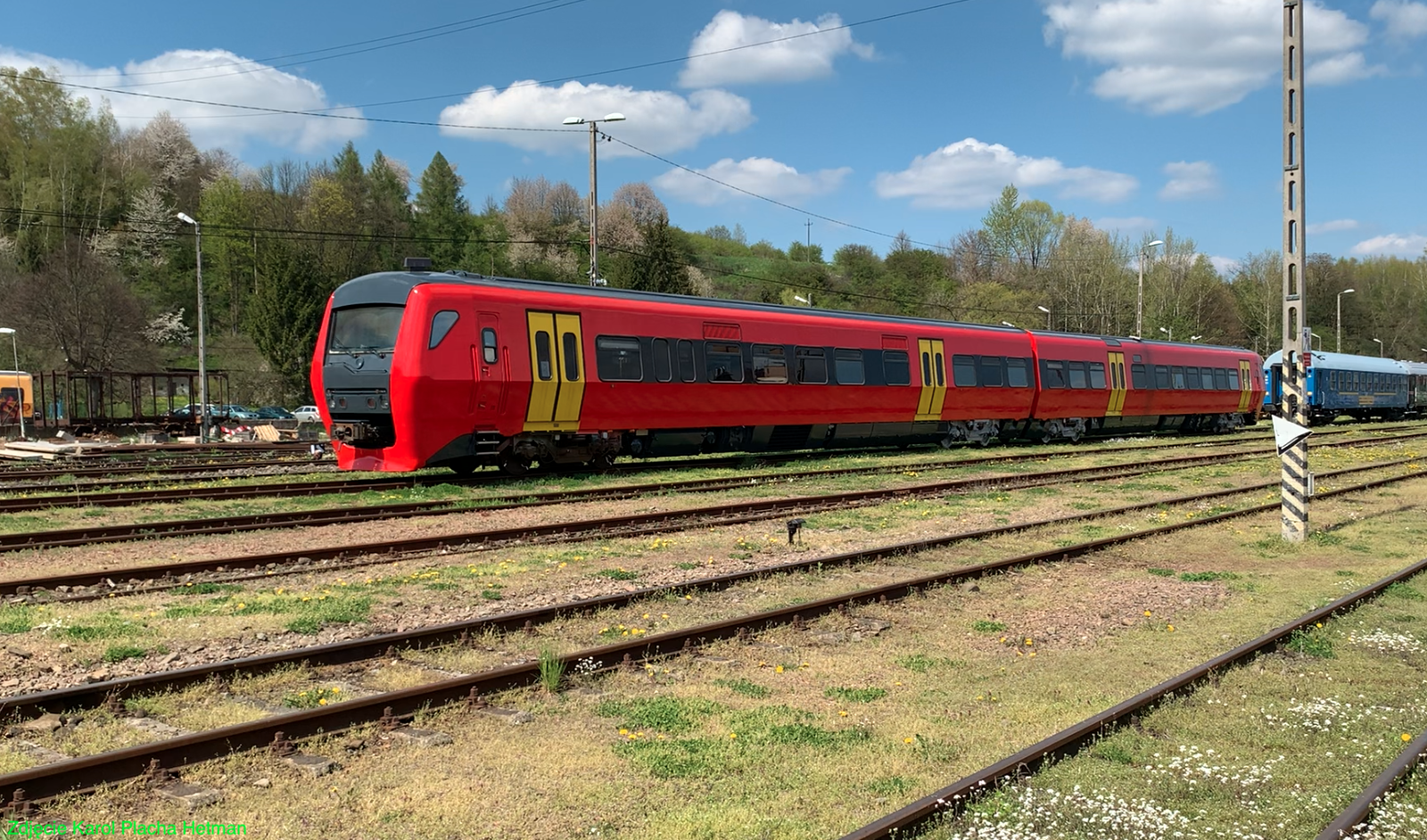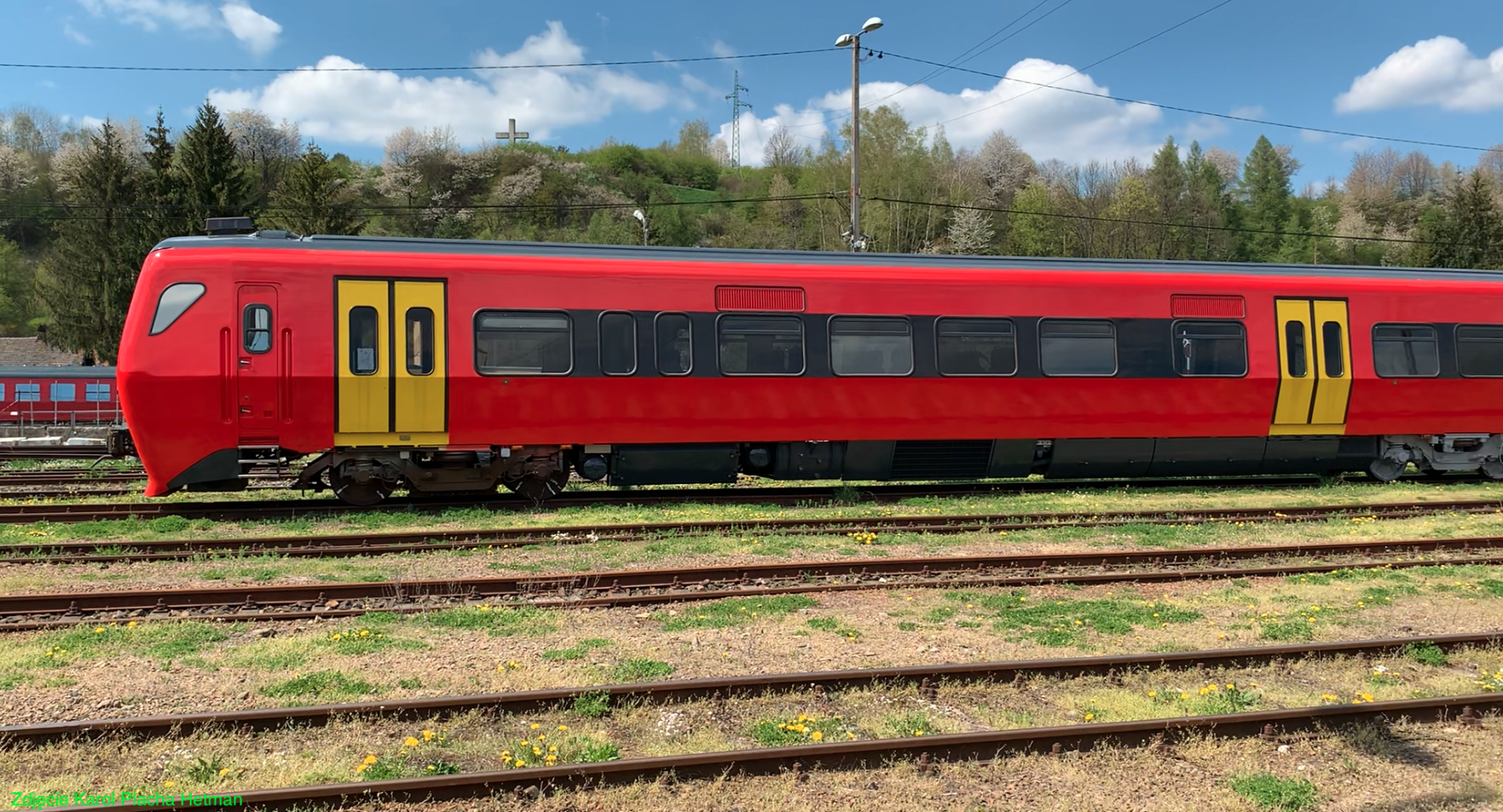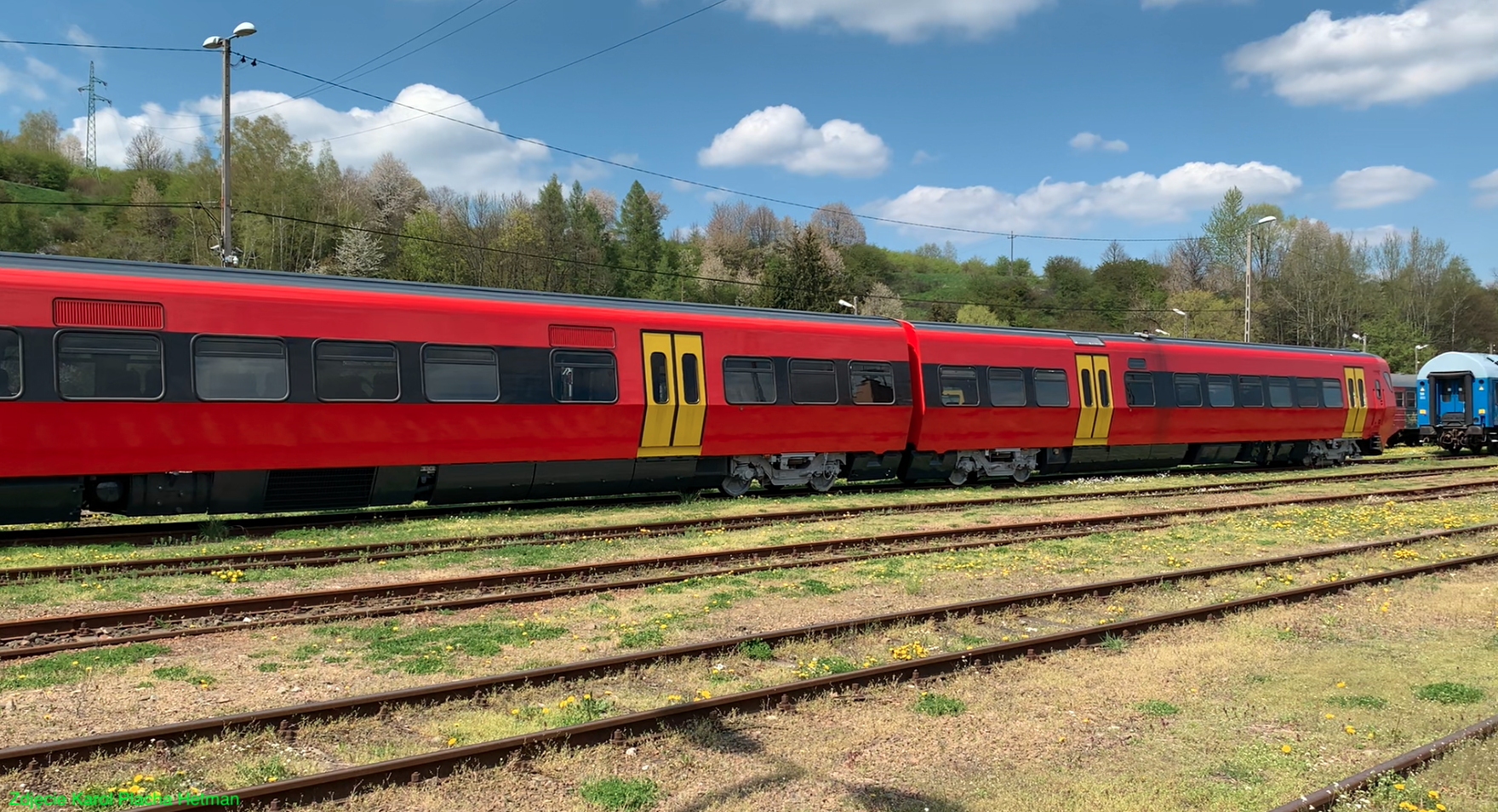Zagórz 2023-05-06
Diesel Multiple Unit SD85, previously DM90.
In November 2020, the Polish railway carrier SKPL confirmed that it would buy 32 DM90 MGs from the Dutch carrier. The talks lasted from December 2019. So far, the SKPL company has mainly used the SN84.




DM90 trains in Poland received the SD85 designation and were approved for operation on Polish tracks. The SKPL company subjected the trains to polonization. One of the most important elements was the addition of additional entrance stages. It was a necessity, because SD85 trains run mainly on routes with low platforms. Originally, all SZT DM90 trains were painted yellow. In Poland, they were repainted in the colors of the SKPL carrier, i.e. red, and the doors in yellow. The SKPL company already has experience in polonizing trains from the Netherlands, for example DH1 and DH2.
There was a doubt about the gauge of the DM90 trains, which is said to be 3.20 m at its widest point. According to the assurances of the SKPL carrier and the Rail Vehicles Institute, the trains fit on platforms and on routes. The actual width of the boxes is 2.883 m. This episode is believed to have resulted from a failed sale of DM90 PCS to Romania. In 2017, the carrier Nederlandse Spoorwegen sold 48 DM90s to the Romanian carrier Ferotrans. However, Romania did not fulfill the agreement and until April 2018, it did not settle its finances and did not receive the trains. The case went to court. The Romanians claimed that the carrier NS did not provide the relevant documents, and the trains were too wide for the Romanian tracks. Therefore, the court annulled the transaction and the trains were put up for sale again.
The trains were transported from the Netherlands to Poland in sets of 4 DM90 (SD85). The trains are about 25 years old. They were built for the Dutch Railways (Nederlandse Spoorwegen) NS. In the Netherlands, they were operated until 2018. The Dutch carrier has taken the DM90 trains out of service, as most of the railway lines in the Netherlands are already electrified. The second reason was the low capacity of the vehicle in Dutch conditions. A partial solution was the conversion of two trains, NS 3446 and 3447, into 3-car trains. But then the dynamics of the train's movement decreased. DM90 PCS were produced in the late 1990s.
The contract price is a trade secret. It is known that the SKPL carrier partially took out a bank loan. Besides, the purchase of new ITEMs from NEWAG or PESA would be significantly more expensive. You also have to remember that the new trains are not on the slope, and the DM90 trains were available for purchase immediately. The trains were transported to Poland to Zagórze and Koźmin Wielkopolski. Vehicles purchased are NS; 3402, 3404, 3406, 3407, 3411, 3413, 3415, 3421, 3425, 3427, 3428, 3429, 3430, 3431, 3432, 3433, 3434, 3435, 3436, 3437, 3 438, 3439, 3440, 3443, 3444, 3445, 3446, 3447, 3448, 3449, 3450 and 3453.
Currently (2023), it is not known on which routes SD85 trains will run. Everything will depend on the needs of the market. It is not difficult to guess that these will be mainly non-electrified routes, with a small stream of passengers and will be directed to places where freemasonry until 2015 liquidated railway connections, railway stations and passenger stops. The SKPL carrier also informed that the trains may appear on the tracks of other Central European countries.
On December 30, 2022, tests of the first SD85-001 (former NS 3429) began. The train traveled from Zagórz through Sanok to Jasło.
SD85 is a diesel multiple unit consisting of two cars. The vehicles are equipped with air conditioning. All seats on the trains have been replaced with new, single seats. Trains started regular runs from June 2023. One of the first relations is Zagórz - Kraków - Kłodzko Miasto. This is a route that has already been operated by SKPL, commissioned by PKP InterCity. In October 2022, PKP InterCity announced a tender for the operation of diesel trains on certain railway routes. The offer was for 4 years, with the possibility of extending it for another one year. PKP InterCity's offer required air-conditioning in trains. During the negotiations, there was talk of 2-4 car trains.
The SKPL carrier wants to use SD85 trains on the following routes: Kraków - Zagórz - Łupków, Kraków - Nysa - Jelenia Góra - Kłodzko Miasto, Kraków - Nysa - Jelenia Góra - Kudowa-Zdrój.
In April 2023, information appeared about a new connection between Poland and Ukraine. The railway route leads; Warsaw - Dęblin - Lublin - Zwierzyniec - Lubycza Królewska - Rawa Ruska. The first course for which the train was made available by SKPL has already been completed. It seems that after 20 years, the Hrebenne - Rawa Ruska border crossing will be reopened. Let us remember that PLK never liquidated this crossing, only carriers were not interested in it. The Ukrainian side renovated the 1435 mm track, which allows trains from Poland to reach the Rawa Ruska station. Here, travelers will change to Ukrainian trains (wide gauge) and go to Lviv. Regular Warsaw - Rawa Ruska trains will probably start in June 2023.
SD85 (previously DM90).
SD85 is a diesel multiple unit consisting of two cars. The manufacturer of the vehicles was the factory in West Germany, Waggonfabrik Talbot, in the period 1996 - 1998. The vehicles were marked DM90, and in the Netherlands NS-3400. A total of 53 were built. DM90 PCS were used on local routes in the Netherlands; Leeuwarden - Wolvega and Groningen - Zwolle.
Axle arrangement 2'B'+2'B'. Service weight 74,620 kg. Total length 44,800 kg. Width 2.883 m. Height 3.89 m. Wheel diameter 0.76 m.
There is one KHD F12L413F 12-cylinder diesel engine in each car. The engine is located under the floor of the car. The engine power is 478 kW. The engine drives the wheels via a Voith T320 hydraulic transmission. The engine exhaust system was led above the roof of the car. The acceleration of the train is 0.76 m/s2. The operational speed is 140 km/h. The train is equipped with pneumatic and magnetic brakes.
The car bodies are placed on two bogies, one driving and one rolling. The trolleys have double shock absorption, one of which is pneumatic. The vehicles are equipped with air conditioning. All seats on the trains have been replaced. There are 131 seats on the train. The train can take a total of 273 passengers, with a load of 5 people / m2. Passenger doors are double, bouncing - sliding. They have been equipped with additional folding steps. The entrance door to the driver's cab is on both sides and opens inwards.
The heads of the trains are equipped with Scharfenberg couplers, which enable multiple driving. The windshield is one-piece with two wipers. There are six lights in the head of the train; two red (end of train) and three white.
Written by Karol Placha Hetman
